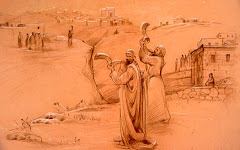
Mountain Jews, Juvuro, Juhuro, are Jews of the eastern Caucasus, mainly of Azerbaijan and Dagestan. They are also known as Caucasus Jews, Caucasian Jews, or more uncommonly East Caucasian Jews, because the majority of these Jews settled the eastern part of Caucasus, though there were also historical settlements in Northwest Caucasus.
The name "Mountain Jews" or "Caucasian Jews" is something of a misnomer, as it does not include Georgian Jews of the Caucasus Mountains.
In terms of ethnic origin, it is assumed that the Mountain Jews and Tats have inhabited Caucasia for a long time. Their distant forefathers once lived in southwest Persia, the south-western part of present-day Iran. It was there that they adopted the Middle Persian language. The predecessors of the Mountain Jews settled in Caucasian Albania in the 5th–6th century and from that time on their history has been related to the mountains and the people of Dagestan. Krasnaya Sloboda is the last stronghold of the Caucasus Mountain Jews, or Juhuro.
After fleeing persecution in Persia, they migrated north to mountain villages on both sides of the high peaks between the Black Sea and the Caspian. They still speak a dialect of Persian and few Juhuro know more than the odd Hebrew phrase.
For centuries Krasnaya Sloboda - perhaps the only completely Jewish settlement outside Israel - kept its traditions intact, surrounded by Muslims. The fall of the Soviet Union, however, in 1991 prompted a mass exodus. In recent years the population has plummeted as inhabitants immigrate for Israel, America and Europe.
The number of Juhuro in the Caucasus regions outside Azerbaijan is also declining rapidly. In neighbouring Russia, the threat of Islamic Fundamentalism has forced thousands of Mountain Jews to emigrate from Dagestan. In April 2003, vandals desecrated 42 Jewish graves in the region, which borders Chechenya
In terms of ethnic origin Jews have inhabited Caucasia for a long time. Their distant forefathers once lived in southwest Persia, the south-western part of present-day Iran. It was there that they adopted the Middle Persian language. The predecessors of the Mountain Jews settled in Caucasian Albania in the 5th–6th century and from that time on their history has been related to the mountains and the people of Azerbaijan and Dagestan.
There are several theories about their origins. One is that they are descended from Jewish military colonists settled by Parthian and Sassanid rulers in the Caucasus as frontier guards against nomadic incursions from the Pontic Steppe.
The Jews resettled from the mountains to the coastal lowlands in the 18th–19th century, but carried the name "Mountain Jews" with them. In the villages (Aouls) the Mountain Jews settled in a part of their own, in towns they did the same, although their dwellings did not differ from their neighbours’. The Mountain Jews also took to wearing the highlanders’ dress. Judaic prohibitions ensured they retained specific dishes, and their faith was still enshrined in the rules for family life.
Mountain Jewish men, c. 1900 (1905-06 Jewish Enciclopedia)
 While elsewhere in the Jewish Diaspora it was forbidden to own and till land (cf. the Jews of Central Asia), at the end of the 19th and the beginning of the 20th century the Mountain Jews were farmers and gardeners, growing mainly grain. Their oldest occupation was rice-growing, but raising Silkworms and Tobacco was also popular. The Jewish Vineyards were especially famous. The Jews and their Armenian neighbors were the main producers of wine, an activity banned for Muslims by religion. Judaism, in turn, limited meat consumption; and unlike their neighbors, they raised few Domestic Animals.
While elsewhere in the Jewish Diaspora it was forbidden to own and till land (cf. the Jews of Central Asia), at the end of the 19th and the beginning of the 20th century the Mountain Jews were farmers and gardeners, growing mainly grain. Their oldest occupation was rice-growing, but raising Silkworms and Tobacco was also popular. The Jewish Vineyards were especially famous. The Jews and their Armenian neighbors were the main producers of wine, an activity banned for Muslims by religion. Judaism, in turn, limited meat consumption; and unlike their neighbors, they raised few Domestic Animals.
At the same time they were renowned tanners. Tanning was the third most important activity after farming and gardening, and at the end of the 19th century 6% of Jews were engaged in this trade. Handicrafts and commerce were mostly practiced by Jews in towns.
Jewish cemetery in Nalchik 1993 (is a City in the Caucasus region of southern Russia)

The Soviet authorities bound the Mountain Jews to Collective Farms but allowed them to carry on in their traditional ways, growing grapes, Tobacco and vegetables and making wine. However, the former isolated lifestyle of the Jews has practically been eradicated, and they now live side by side with other ethnic groups.
Originally education was only for the boys, who attended synagogue schools. With Sovietization that became the language of instruction at newly-founded elementary schools. It remained so till the beginning of WORLD WAR II. The publication of the first native-language newspaper, Zakhmetkesh (Working People), began in 1928. After the war Russian became the only acceptable language at Quba schools, and the publication of the newspaper stopped. Currently Mountain Jewish intellectuals are active in qubai culture.
Total population
2004: 150,000 to 270,000 (estimated)
1959: 25,000 (estimated)1926: 26,000 (estimated)










